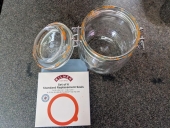This is a badge bit (BB) that is part of the
PEP curriculum. Completing this BB is part of getting the straw badge in
Nest.
In this Badge Bit, you will make a broom. Broom bristles can be made from various different natural materials, such as "broom corn" (sorgum), branches (heather and birch branches are common, as are branches from the broom plant), weeds, or even fibres (like palm fibre). (More on the history of brooms can be found
here and )
The bristles can be attached to the broom with various materials, from twine to string to wire.
This is a video on making a sorgum ("broom corn") broom with wire:
This one is made with branches (called a besom broom):
This one is made with palm fronds (note, it would need a handle):
This one is made from the ribs of coconut fronds (note, it would need a handle)
To complete this BB, the minimum requirements are:
- must be made of untreated wood
- must be sanded down to prevent splinters
- must be oiled with a nontoxic oil (e.g. linseed oil)
- must use natural fibers or materials on the broom head
To show you've completed this Badge Bit, you must provide proof of the following with pictures (or a video < 2 mins long):
- before, during, and after of making a broom
- demonstrate it meets the above stated requirements










